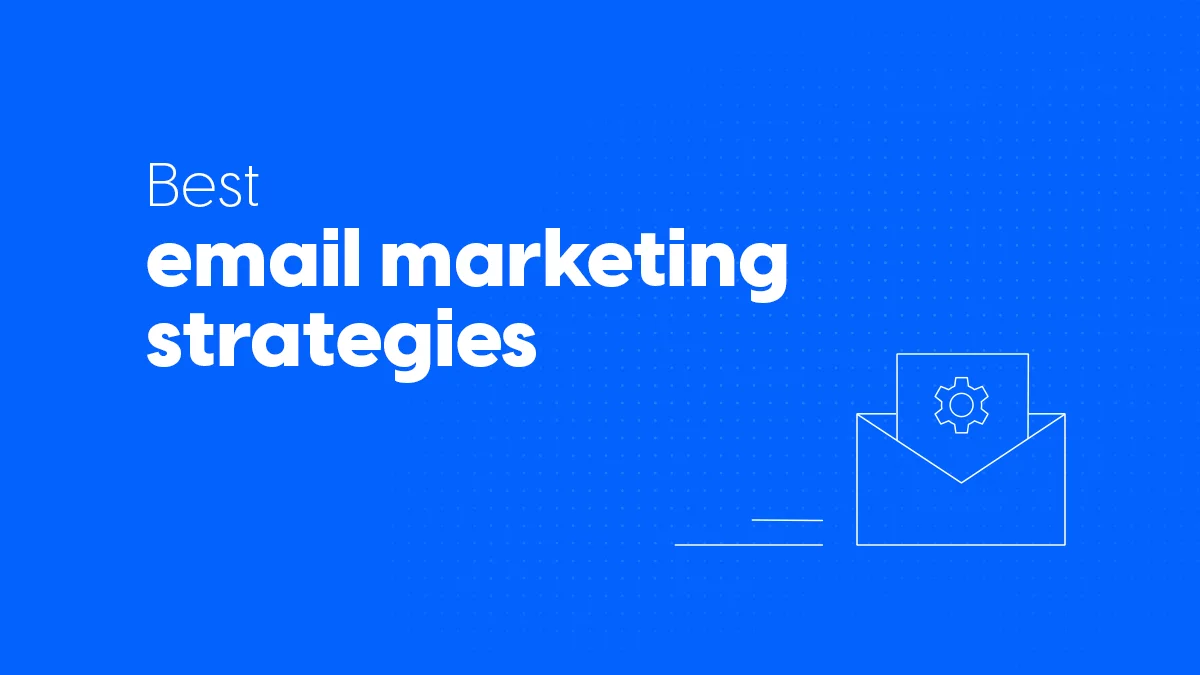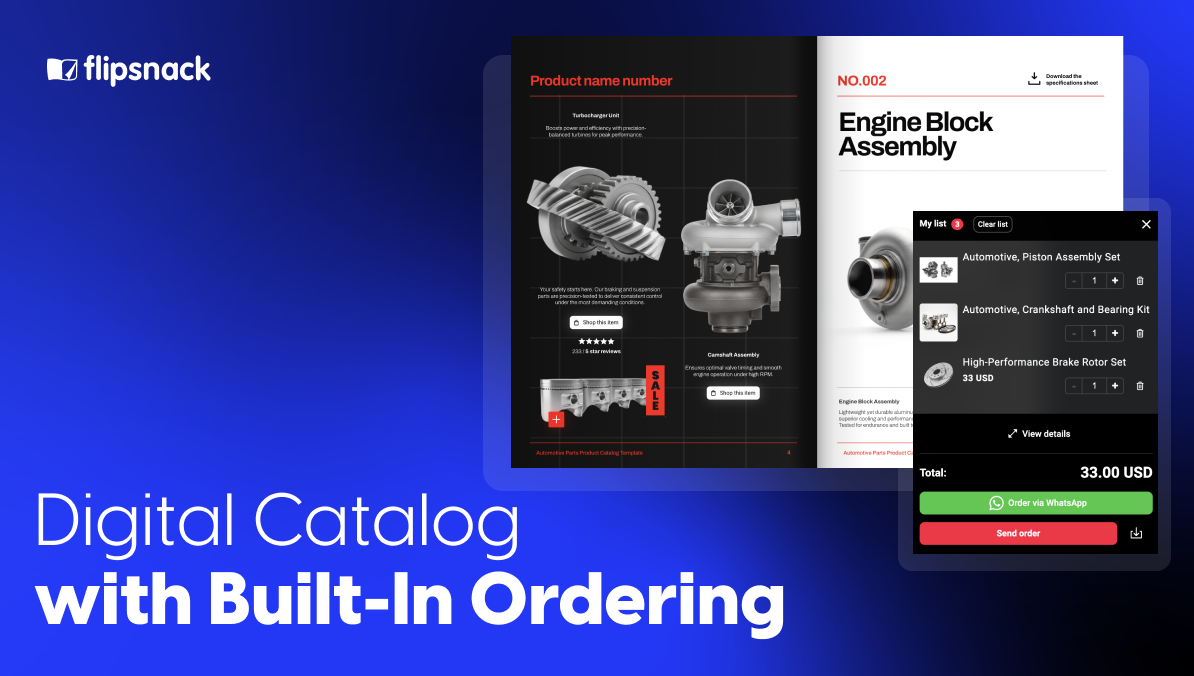8 best email marketing strategies for beginners
Despite the high rise of social media over the past years, email marketing remains one of the elite channels for business communication. Over 144 billion emails are sent every day, and more than 58% of people check their emails as soon as they wake up. But that’s not all. An email is also considered to be a revenue-driving machine. Being the most powerful marketing channel in terms of ROI, emails return at least $40 for every $1 you spend.
Pretty impressive statistics, right? Hopefully, they’ll convince you to start using email marketing to drive sales and revenue for your business. But how will you do this if you’re new in this field? Don’t worry about it, we’ve gathered eight of the best email marketing strategies that could help any beginner get started. However, before taking them one by one and explaining them, we should focus on answering other important questions:
What is email marketing and why it is important?
In just a few, simple words, email marketing means building strong relationships with your audience through emails. The best email marketing strategies help you promote your products or services of your business and also help you convert prospects into long-lasting customers.
Now that we’ve covered this significant question, it’s time to discover why email marketing is important to your business. There are many reasons why should make email marketing one of your top priorities, but we’ve chosen these top three you should focus on:
- Emails help you get higher engagement rates than social media does. Your emails will reach around 85% of your target recipients. This instantly increases the chances that your readers will see your content, compared to social media where you have little control over whether followers will even see your posts. Besides, emails have a click-through rate of 3.71%, or more than 6x the engagement rate of Facebook, Instagram, and Twitter altogether.
- Emails are low-cost, but provide a high email marketing roi (somewhere around 4400%). A study from 2018 places the ROI at an average of $38 return per $1 spent, while other studies place potential returns up to $44 return per $1 allocated for email marketing activities
- Emails are easy to track. The internet is full of software providers. For example, CampaignHQ and Sender allow you to track the results of your campaigns. By doing this, the data you gather show how much revenue your email campaigns have generated. At the same time, you can more easily discover what went right and wrong, so that you know how to improve your future email marketing campaigns.
Why is it essential to have an email marketing strategy?
It’s vital to have a strategy for your email marketing campaigns for various reasons. Here are some of the most important and significant ones:
- An email marketing strategy helps you plan ahead when to send time-based promotions and non-promotional emails. For the time-based promotions, marketers should consider planning a short three-part marketing email series consisting of an announcement (preferably two weeks in advance), a reminder (1 week to the event), and the last chance (1 or 2 days before the event.) The non-promotional emails are less timely and sales-driven. They also enable marketers to determine the interests of their subscribers, hence helping with mailing list segmentation. More on this subject later.
- The best email marketing strategies help you gauge your results. No matter the type of your business or company, you should always have some marketing objectives in advance when implementing an email campaign. This way, you’ll know if the objectives you’ve chosen were achievable or effective enough, or you’ll need to choose better for your next email campaign.
- Email marketing strategies help you pick the best tips and tricks that a marketer could use to push their strategy and hence, achieve the ultimate goal: converting as many customers as possible. To put it bluntly, driving prospects down the funnel won’t happen by accident. You need to choose the right tactics in order to build strong relationships with your potential clients.
That being said, it’s high time we talked about what matters most:
8 best email marketing strategies for beginners – a complete guide
Believe it or not, each of your customers receives approximately 100 emails every day. That means, if you don’t take the time to develop a strong plan of action, your emails will get lost in the crowded inboxes, or worse, be sent to the spam folder.
Luckily for you, you can learn how to build an effective email marketing plan and send emails that people actually want to read. All you have to do is to put into practice these eight best email marketing strategies for beginners. We’ll take them one by one and explain them in precise detail. Also, enjoy the examples we’re going to share. You can use them as sources of inspiration for your next email marketing campaigns. Ready? Let’s get started!
Here are 8 best email marketing strategies for beginners:
- Segment your subscribers to get better open and click rates
- Use personalized messages to increase customer retention
- Optimize your email messages for a better mobile experience
- Test all your emails in order to improve your marketing performance
- Automate email campaigns when possible to increase sales
- Re-engage inactive group of subscribers as much as you can
- Create a strong lead magnet to attract more clients
- Measure your results to see how your campaigns are performing
Let’s analyze and exemplify them more thoroughly:
1. Segment your subscribers to get better open and click rates
Our list with best marketing strategies starts with the segmentation part, of course. This represents the process of breaking your subscribers into smaller groups based on specific criteria, so that you can send them more personalized and relevant emails. Without doing this, you risk sending the wrong content to the wrong people and losing subscribers.
Besides this, the segmentation part has other important benefits, such as increasing your email open rates, boosting your click-through rates, and decreasing your unsubscribe rates. If you’ve ever wondered how successful marketers always have effective email campaigns, you’ve just received your answer: they drastically segment their email lists.
Speaking of this, it’s worth mentioning that the more you segment your email lists, the better. You’ll build more trust with your leads, and it will be easier to convert them later. Not to mention that segmented emails generate 58% of all revenue.
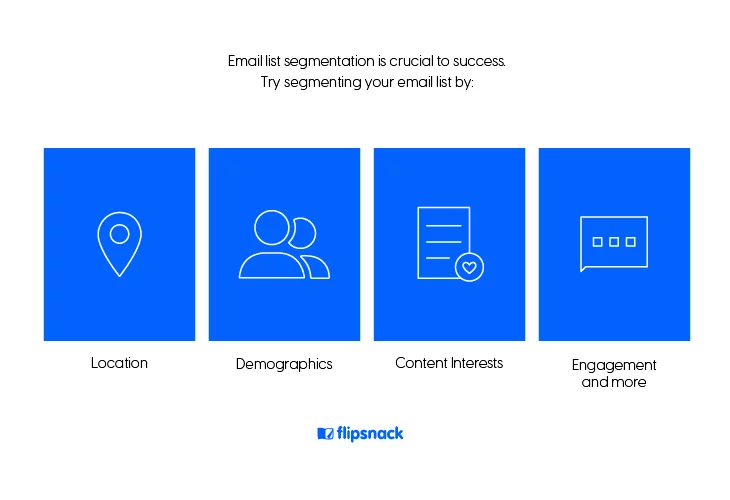
That being said, here are a few examples of basic email segments to consider:
- demographic information: age, gender, marital status, income, etc.
- personal preferences or interests
- newsletter subscribers
- current customers
- potential clients
- contact engagement with communication: page visits, link clicks, email opens, etc.
- contact buying behavior: products purchased, products added to cart, etc.
In fact, you can choose to segment your emailing list any way that you want. Just make sure to pay attention to what kind of message you send to each subgroup.
2. Use personalized messages to increase customer retention
Now that you know who you’re emailing and what’s relevant to your audience, it will be much easier to send emails with personalized touches. It’s essential to do so if you want people to open and interact with you.
However, personalization is not only about using people’s names in messages, but also creating a genuine relationship with them and making them feel special. When your readers open your emails, they should feel like the content is tailored for them, or feel like you are having a talk with them. A tool like an AI writer can instantly create marketing copy that converts for personalized email campaigns. Another way to achieve this is to start using the word “you” or incorporate a creative video greeting card to boost emotional connection and engagement. It’s a very powerful word that will make your subscribers open your emails. Here is an example in this regard by Grammarly:
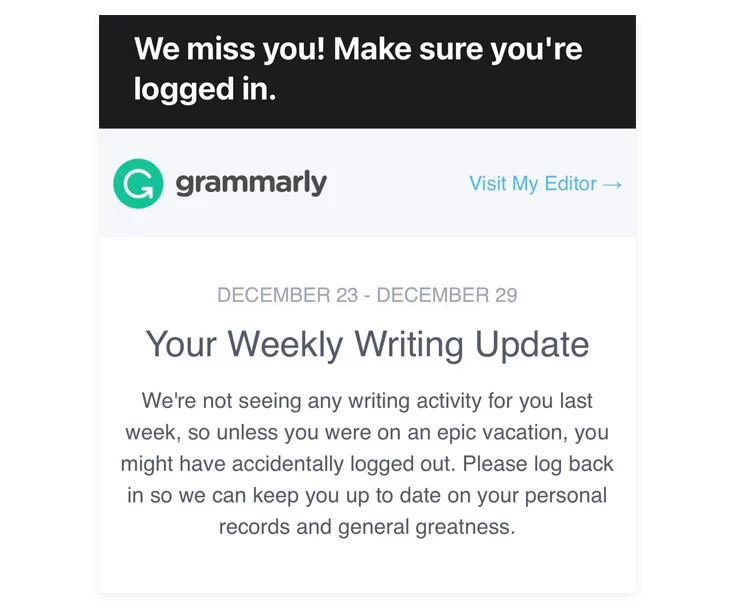
If you’re still not convinced that personalized messages are one of the best email marketing strategies, then these statistics might impress you a bit. Personalized messages have 26% higher open rates and an improved click-through rate of 14%. Quite amazing, right? So, next time you’ll organize another email campaign, make sure that you’ll think of including this strategy, otherwise you’re going to miss a lot of sales opportunities.
And because you’re new in this field and everything might seem overwhelming for you, we’ve thought of helping you with a few ideas to personalize your emails:
- add a first name field in your subject line and/or greeting;
- emphasize the personal pronoun “you”;
- include region-specific information when appropriate;
- mention relevant and personal events, like region-specific holidays or birthdays;
- end your emails with a personal signature from a human;
- use a relevant call-to-action to an offer that the reader will find useful.
3. Optimize your email messages for a better mobile experience
Today, more than 61.9% of emails are opened on mobile devices, and we totally understand why. As soon as we get up, we grab our phones to check our calls, social media accounts, and yes, you’ve guessed it, our emails…It’s easier to check our phones if we’ve got something in our inboxes than turning on our laptops, logging in, and so on.
Therefore, your next concern should be to optimize email content for mobile to also reach this kind of audience. It’s totally worth it, because the average revenue per mobile email is $0.40, which is more than 4x that of a desktop email click. From now on, you need to make sure that all of your emails you’re sending are responsive and include easily loadable media. Otherwise, your readers will delete your emails or choose to unsubscribe.
Here are some tips and tricks that you can use to create a mobile friendly email content:
- keep the subject line and preheader short;
- keep the formatting simple (single-column), under 600px wide;
- use larger fonts, because small fonts are difficult to read on mobile;
- use smaller images to reduce load time;
- make the CTA big and obvious;
- avoid certain words that can trip spam filters and cause your email to never see the light of day.
Example of an optimized email message for mobile:
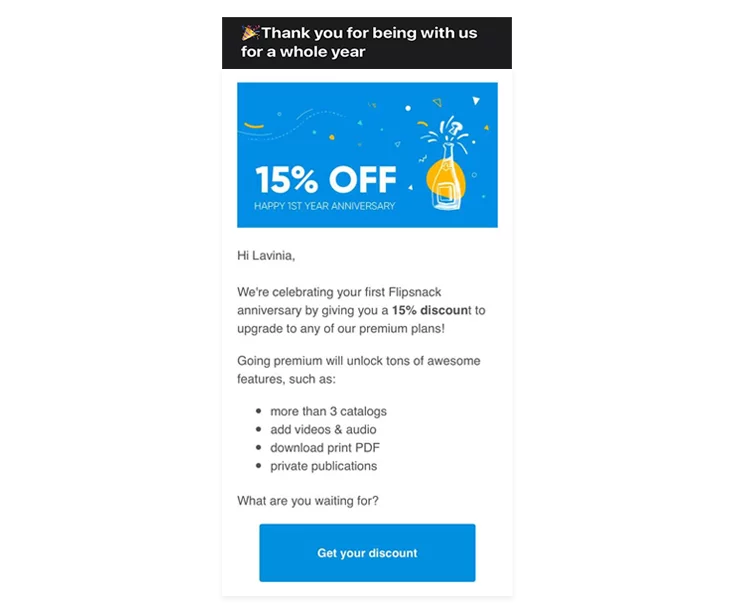
4. Test all your emails in order to improve your marketing performance
A/B Testing
When it comes to email lists, one thing’s for sure: they are not created equal. Some audiences prefer a more personalized subject line, others will think it’s too spammy. Some audiences prefer eye-catching CTAs, others will opt for more subtle ones. And the list could go on. Truth be told, you’ll never know what kind of people make up your email list until you test the variables. And you can totally do this with the help of A/B testing. The internet is filled with such tools. All you have to do is to browse through Google and find the perfect one for your needs.
Being one of the best email marketing strategies, A/B testing or split testing, allows you to see what type of email performs excellent with your audience by analyzing the results of email A against email B. Based on the results you’re obtaining, you can tweak your email campaigns and improve your KPIs.
Your email A/B testing strategy should include:
- subject lines;
- CTAs;
- images;
- body text;
- headlines;
- closing text;
- personalization, etc.
Keep in mind to not test all this list at once. Pick one or two elements and see how that improves conversions before testing the next two or more elements. It’s important to know why you’re testing specific elements before you run a test. For instance, you test subject lines for open rates, images for conversion rates, CTAs for click-through rates, and so on. Keep track of these results because they will improve your future email marketing campaigns.
Here it is an example in this regard:
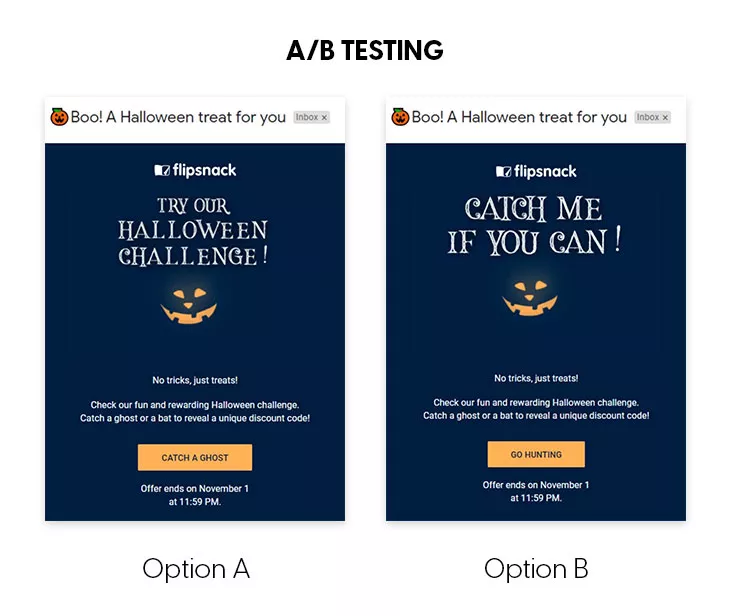
Spam Testing
Since we’re here talking about email testing, it’s also crucial to mention that you should perform spam tests in order to improve your email marketing campaigns. Many businesses – be they small or big – don’t get the desired results because they have poor deliverability and open rates. If you’re also in this situation, then you know what you should do next: run a spam test campaign and analyze the results.
During a spam test, the spam checker tool goes through your entire email content. It verifies different things such as:
- subject lines that are too long, too short, or too spammy;
- all words written with capital letters;
- amount of exclamation points used;
- any lorem ipsum text;
- spam terminology and a list of spam words;
- long and wordy emails;
- HTML code;
- links and images;
- IP reputation.
After analyzing everything, the spam checker tool you’re using will give you relevant feedback. Based on the feedback, you can make the necessary changes in order to improve your email marketing campaigns and to boost your email deliverability.
Speaking of helpful spam checker tools, it’s worth mentioning our experience here at Flipsnack:
“Deliverability is a crucial aspect of our email marketing, and one of the main things we are always focused on improving. This is why it was extremely important for us to find the best spam testing tool – which for us is Glockapps – that would allow us to see what we were lacking in our email templates and where our emails were landing”, says Diana Lascu, our email marketing specialist.
Here’s an example of one of Flipsnack’s email placements, after we implemented the suggestions of improvement from Glockapps:

5. Automate email campaigns when possible to increase sales
We couldn’t make up our list of best email marketing strategies without including automation. Unlike the regular email campaigns, the trigger-based emails are the ones that are sent out automatically based on email list segmentation and user behavior. The most common forms of trigger emails are welcome emails, thank you emails, follow up emails after a purchase, confirmation emails, email receipts, etc. We’re pretty sure that all of you have received at least one email of this kind, so you know what we’re talking about.
Studies show us that automated emails perform much better than traditional ones, so it’s high time you started taking advantage of this effective email marketing strategy. The average click-through rate for trigger emails is more than double compared to traditional email click-through rates, according to Epsilon. And even more impressive, it has been demonstrated that trigger-based email marketing campaigns can generate 4x more revenue and 18x greater profits!
Another amazing aspect of email automation is that it will not only convert leads into prospects but will also delight existing customers and encourage them to utilize and buy your products. This will boost upsells and additional purchases. And it’s not difficult or expensive to use a good email automation platform that will help you in this regard. Just search Google. It will give you thousands of options, such as Mailchimp, SendX, Mautic, Drip, ConvertKit, Sendinblue, and so on.
Here are two examples of automated email campaigns, the first one is from Asos and the second one from Shutterstock. You can use both of them as inspirational sources:
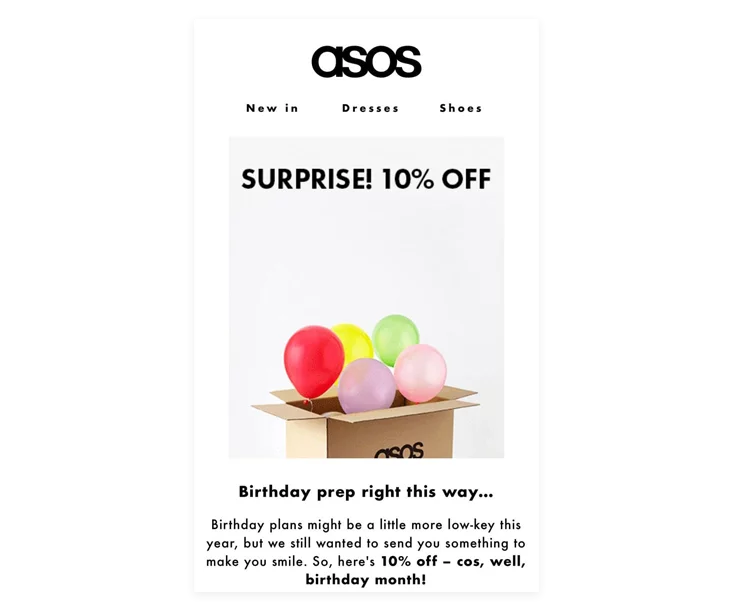
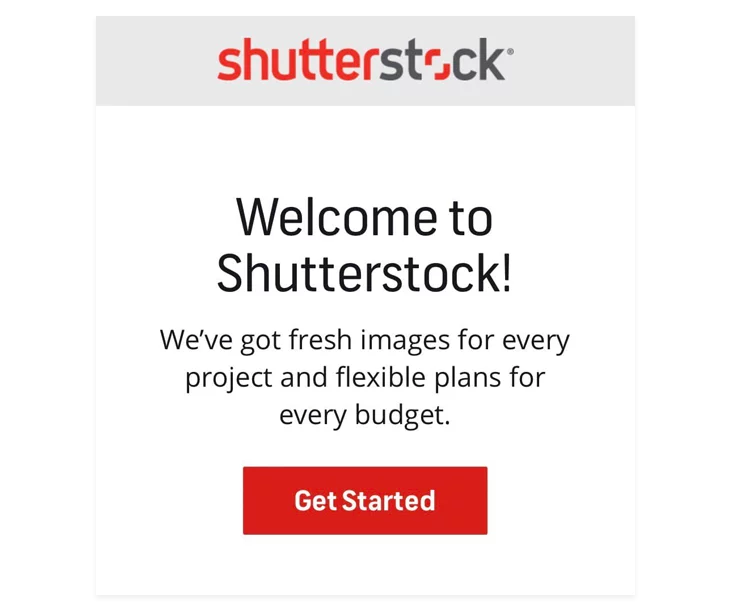
6. Re-engage inactive group of subscribers as much as you can
Well, you know what they say: it’s easier to engage current subscribers than trying to win new ones. We couldn’t agree more. The subscribers you already have – be them active or inactive, know a lot more about you than the ones who just signed up. Furthermore, studies show us that on average, an inactive subscriber is worth 32% of an active one. To put it another way, if you don’t try to win back your inactive subscribers, you’re risking losing a lot of revenue. With this in mind, you should start thinking about one of the best email marketing strategies: re-engaging as many inactive subscribers as possible.
However, you should pay high attention when doing this. Keep in mind that emailing your inactive users impacts your open rates. And if your open rates drop low enough, your email reputation will suffer. Before you begin a re-engagement email campaign, you must identify your inactive email subscribers and separate them from the rest of your list. Segmenting your inactive subscribers achieves two important things. The first one – you stop sending them the same emails as your active subscribers, which will keep your open rates from dropping. And the second one – you’ll be able to send your inactive subscribers targeted email marketing campaigns created especially for re-engagement goals.
That being said, how do you re-engage your inactive subscribers? There are many ways by which you can do this. You can try to conduct polls, surveys, or send them a “we miss you” email. However, it would be useful to rely on a bulk email finder tool to ensure that your previous contacts are still accurate. This way, you show them how important their opinion is to you and how much you care about them. Or, you can send them exclusive gifts or promotions that are hard to ignore. Gifts always motivate subscribers to make a purchase.
Here is an example in this regard from Lucidpress:
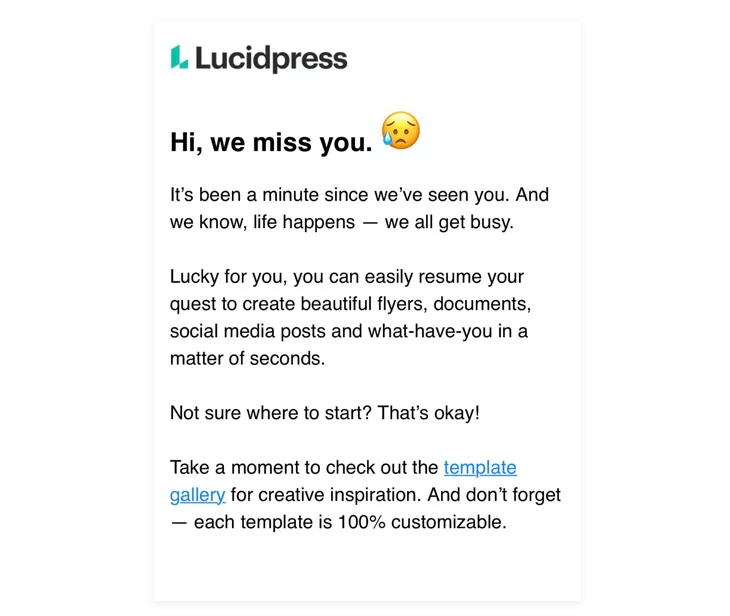
7. Create a strong lead magnet to attract more clients
Everybody who owns a business – be they beginners or experts – wants to attract more and more clients. We’re sure that it’s your case, as well. Right after they land on your website, you wish people to sign up for your email list. But how should you do this to make it as natural and successful as possible? The answer is simpler than you think: you create strong lead magnets.
But what exactly is a lead magnet? It’s a kind of incentive you give in return for your visitor’s email address, that helps you find email addresses of potential clients. It doesn’t have to cost you anything to create. Most commonly, lead magnets come in the form of an ebook, a checklist, free tools, webinars, and so on. It can be absolutely anything you want, as long as it provides value to your visitors for free.
Recent studies showed that marketers have seen the highest conversion rates with video webinars and guides. But this shouldn’t tell you that you can’t use other kinds of incentives. It’s crucial to use different types of lead magnets, depending on the type of industry you’re in, the type of audience you’re trying to attract, or the goal of your email marketing campaign. For instance, ASOS offers discounts for clients who are purchasing for the first time from their online shop:
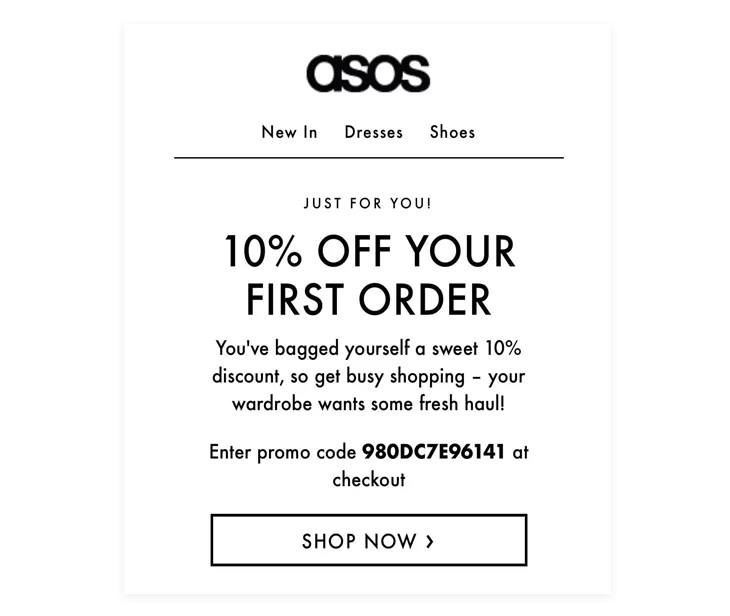
Trello offers free webinars in exchange for clients’ email addresses:
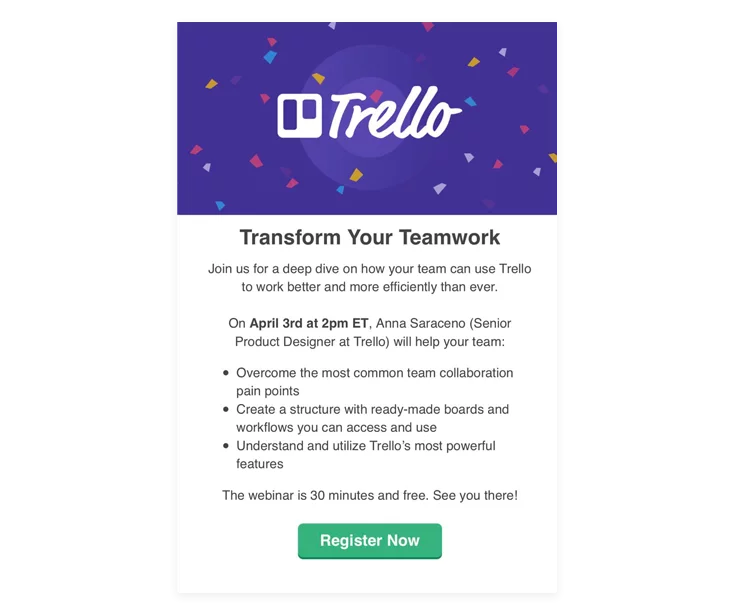
No matter what you’re going to choose, make sure to create strong lead magnets that are specific to your business and valuable for your customers. They are one of the best email marketing strategies, because they can dramatically increase your subscriber rate.
8. Measure your results to see how your campaigns are performing
Our list with best email marketing strategies ends with measuring our campaigns’ performance. This should come as no surprise, since marketers like to keep track of everything. In fact, you can’t run good email campaigns without seeing what went wrong and what went right. Being meticulous about every key metric will help you make changes to your email campaigns that will improve your results.
Once you’re done with an email campaign, you’ll feel very relieved because a lot of work is over. But you should keep in mind to spend as much time measuring your email campaigns as building them. Give yourself at least 24 hours before your start analyzing your results. 24 hours should give your recipients enough time to respond to your message and place their order. After you’ve waited long enough, you can start your thorough analysis.
Here are some of the best email KPIs to track to measure your success:
- deliverability rate – the percentage of total emails that reached your intended subscribers’ inboxes;
- bounce rate – the percentage of total emails sent that could not be successfully delivered for various reasons;
- open rate – the percentage of total emails sent that were opened;
- click through rate – the percentage of recipients who click on one or more links in an email;
- conversion rate – the percentage of email recipients who open the email, click a link, and also complete an intended action, such as downloading a piece of content or making a purchase;
- unsubscribe rate – the number of people who unsubscribe from your email list after receiving any given email;
- sender score/reputation – the probability that an email provider will block your email, deliver it, or mark it as spam.
Now that you know all the results, you can start coming up with new ideas and planning your future email marketing campaigns that’ll generate even higher results. Go the extra mile every single day to achieve even the impossible.
Setting up your first email campaign
You’re finally here, to the last point of this article! Thank you for taking part in this beautiful and informative journey. Hopefully, now you’re ready to put into practice all these best email marketing strategies that we’ve discussed and set your first email campaign. You’ll see that after creating a few, you’ll get more confident with the entire process. All you need to do is to follow this short step-by-step guide on how to set up your first email campaign. It’s a good starting point for every beginner:
- Set a measurable goal
- Pick your target audience
- Create your email template
- Schedule your email campaign
- Measure and improve
We’ll take them one by one and get into more details:
1. Set a measurable goal
First thing first, decide from the beginning what you want to achieve. For the sake of this article, we’ll pretend that we own a fashion company and want to create a welcome email that will greet our new customers and also offer them a free shipping for their first order in our online store.
More than anything, we need to be realistic when thinking about establishing our goals. We shouldn’t forget that it’s our first email campaign that we’re creating. Therefore, we would say that our goal is to build up a welcome email campaign that’ll generate an open rate of over 40% and CTR above 10%.
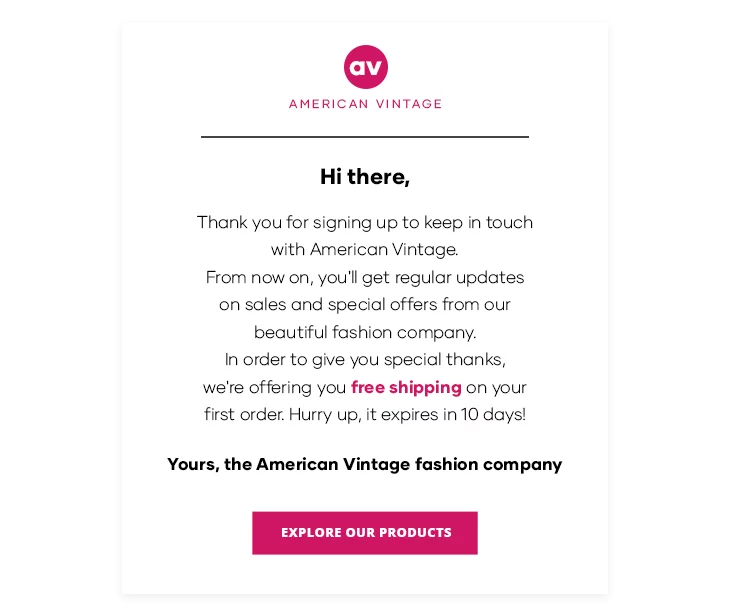
2. Pick your target audience
Step number two is to choose to whom we’re going to send our first email campaign. In this particular case, things are pretty straightforward – our target audience will be every new person who joins our email list. It’s important to always think about our target audience before creating our email template.
3. Create your email template
This step is all about creativity, practice, and patience. We need to craft an email template that we’re going to send to our target audience. Have no worries, we don’t need to be designers or copywriters to conceive email campaigns that generate beautiful results. The most important thing is to always have the target audience in mind and the objective we’ve set for our campaign.
In our case, we want to welcome new email subscribers and persuade them to click through our site and make a purchase using the discount code we’ve offered them. Therefore, we need to create our email in such a way that it’s both approachable and friendly, but also draws the user’s attention to the essential action we want them to take: buy something from our online store.
With all these crucial elements in our mind, we’ll need to create an email template that will have an outstanding and big CTA, surrounded by a reasonable amount of negative space. We’ll also need to pay attention to the colors and fonts, but most importantly, to the message of the email: it has to communicate the benefits of our offer as well as possible.
4. Schedule your email campaign
When we’re done creating the email campaign we wish to send, it’s time to schedule it so that it will reach the right audience at the right time. Most research shows that Monday to Thursday are the best days of the week to send an email. More precisely, sending an email on a Tuesday might result in a 10% higher open rate than any other weekday. The weekend days are thought to perform the worst.
Additionally, the time of day is also crucial. Studies have found that in the morning, between 9 a.m and 11 a.m is often the best time to send an email. It looks like there is a peak at 10 a.m. Furthermore, we also need to take our subscribers’ time zone into consideration. What works best is to create different lists for each time zone and schedule the campaign accordingly.
5. Measure and improve
As we’ve already mentioned, we can’t run good email campaigns if we’re not tracking and measuring the results. Therefore, the last point of our by step-by-step guide focuses on measurements and improvements.
After we’ve sent our email campaign, we should wait at least 24 hours before starting analyzing the open rates, click through rates, and conversion rates. When we’re analyzing the results of our campaign, we should keep in mind the principal factors that could have affected them – the subject line, the email template we’ve used, the targeted audience, the day and hour we’ve sent the email, and so on.
According to the results we’re receiving, we should start thinking about how to improve our next email campaigns. Our goal is to create better and more effective email campaigns that will generate tremendous results.
And keep in mind, that a digital marketing agency can always come to the rescue when it comes to setting a top-notch email campaign.
20 Best Email Testing Tools
Here at Flipsnack, we want to encourage you to test all your emails, so you can make sure that you’re sending out the best version of your email newsletters. As we’ve already mentioned, there are many useful email testing tools that can help you in this regard. To help ensure the success of your email campaigns, we’ve put together this list of 20 best email testing tools:
- Glockapps
- Litmus
- Mailtrap
- Accessible Email
- Putsmail
- Inbox Inspector
- EmailReach
- Email on Acid
- Stripo
- SenderScore
- Postmark
- SendForensics
- Mail-tester
- ReputationAuthority
- Email Checker
- NeverBounce
- SubjectLine
- CoSchedule’s Headline Analyzer
- Send Check It
- Zurb TestSubject
Final thoughts
Great news! You’ve made it to the end of this email marketing beginner’s guide. You know now which are the best email marketing strategies, how to apply them, and also how to set up your first email campaign.
So,…it’s high time you finally put into practice everything we’ve just mentioned. And if you want to dig even deeper into this matter, you might want to check out this article about 7 steps for better email marketing.
Implement all these email marketing ideas into your plan of action and trust me when I say, you’ll see that your customers will be more responsive to your messages, your email campaigns will improve, and your business will continue to grow.
